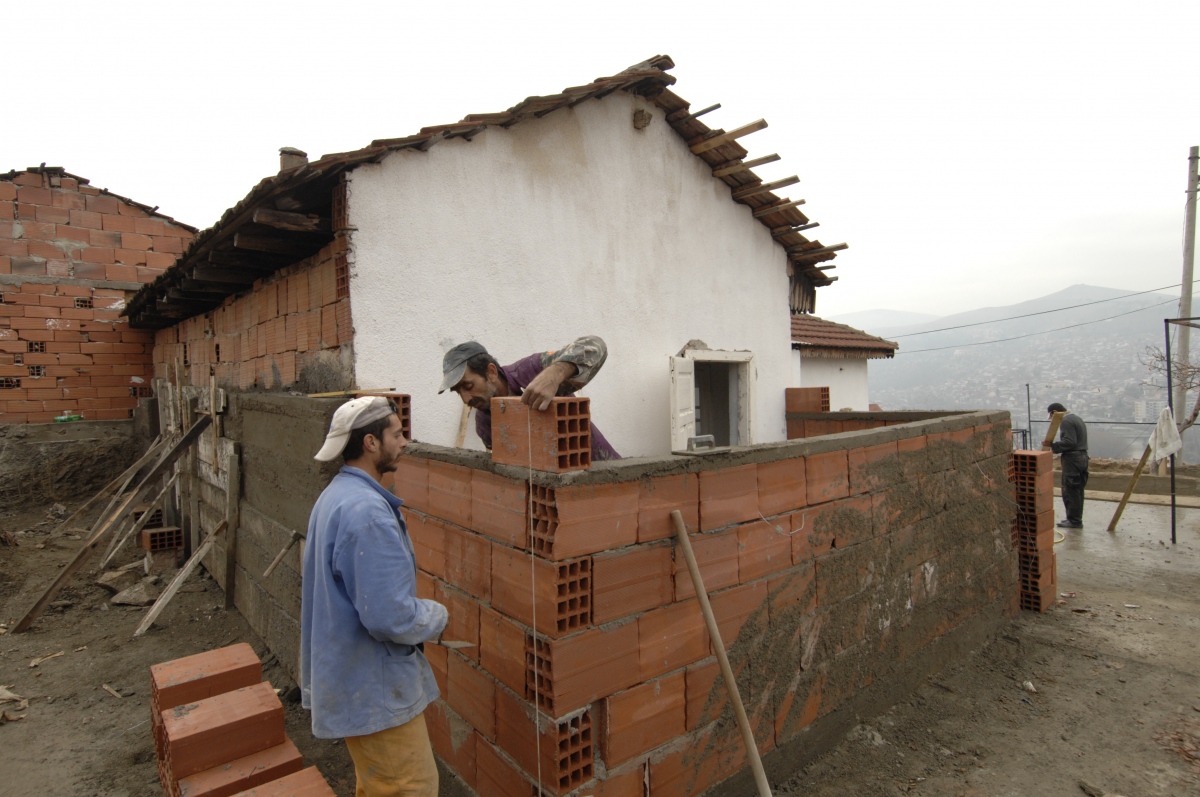 In the framework of the 9th Convergences Forum, e-MFP organised a session on housing microfinance, a topic that, though not new (there are more than 20 years of practice in the sector), it is still rarely addressed within the financial inclusion community and the numbers are quite small, it only accounts for just 2% of MFI portfolios!
In the framework of the 9th Convergences Forum, e-MFP organised a session on housing microfinance, a topic that, though not new (there are more than 20 years of practice in the sector), it is still rarely addressed within the financial inclusion community and the numbers are quite small, it only accounts for just 2% of MFI portfolios!
This little attention together with the fact that finance is strongly needed to support housing needs in developing countries, were the two very first things highlighted by the moderator, Daniel Rozas, e-MFP Senior Microfinance Expert, before giving the floor to the three panellists: Patrick McAllister, Senior Consultant at Habitat for Humanity & Representative of Habitat for Humanity's Center for Innovation in Shelter and Finance; Malkhaz Dzadzua, Chief Executive Officer, JSC MFO Crystal Georgia; and Sothany Chun, Chief Executive Officer, First Finance Cambodia.
McAllister set the context for the discussion stressing some important figures: by 2030 the population needing shelter will have more than doubled, from 1.2 billion today to 3 billion, and the need will be mostly in urban areas, where more than half of the world population lives today and where it is estimated that 2 billion people will be living in slums.
The panel then followed with a discussion that presented the housing finance needs of the bottom of the pyramid (BoP) and the key challenges that the financial inclusion sector needs to address to be able to respond to those needs: clients’ literacy, currency exchange risk and long term funding for both the MFI and its clients.
Habitat for Humanity, a worldwide NGO whose vision is “a world where everyone has a decent place to live”, has realised that for people in developing countries a house is more a process of incremental improvement that takes on average 7 years, than a product that they buy in one go, so traditional housing finance (i.e.: mortgages) is not enough to address the housing finance needs of lower income households. Moreover, to have access to mortgages, financial institutions request both having formal income and formal property titles, something that among the poor is not that common and which makes just a few eligible for this financial product. On the other hand, talking to MFIs, Habitat for Humanity also realised that 20% to 30% of microenterprise loans are already being used for incremental housing. The business opportunity is therefore there for MFIs providing finance to the BoP. As example, Patrick referred to an IFC study in India that reported that 82 % of the households (close to 130 million families) although they wouldn’t be able to access a traditional housing loan, have the needed income to repay a housing microfinance loan. And what is more important, for the sector as a whole if the portfolio invested in housing increases to 10%, we would help improve the houses of 15 million families and benefit their lives.
To showcase how the microfinance sector can address the BOP housing needs and exploit this business opportunity, the two MFIs represented in the panel, presented two different and complementary approaches: Dzadzua explained that JSC MFO Crystal in Georgia offers mainly home improvement loans since 2008; by 2016 their housing loans represent almost 16% of their portfolio (four times the share of 2012) and 75% of them are granted without collateral. According to Chun, First Finance, on the other hand, is the only licensed, specialist mortgage provider granting access to long-term housing finance to underserved Cambodians. Besides mortgages, their main housing product, they also offer home improvement loans and land loans.
All three sector representatives agreed on the two main challenges MFIs need to deal with in order to increase the provision on housing finance: client literacy and lack of affordable long term funding in local currency.
Client literacy involves not only financial education, but also capacity to plan and develop long-term projects such as building a house in environments where usually qualifications of craftsmen and material quality are low and where there are no guarantees and follow up services. As McAllister pointed out, the big challenge is to provide the right support to the clients without increasing the costs either for them or for the MFI. In order to solve this, Habitat for Humanity has taken a dual approach. On one side, they support the MFI in the provision of “BDS” for housing clients, advice on issues such as pricing, planning, materials, environmental issues, eco-building, etc., as well as helping the MFI develop housing loan products adapted to the clients’ needs. Both Crystal and First Finance have partnered with Habitat for Humanity in this regard in order to provide value added services as well as to improve the overall quality of housing stock. On the other side, Habitat also works with the sector value chain in order to help the industry understand the needs of the low income clients and also realise the market opportunity.
The lack of affordable long term funding in local currency is a real bottleneck for the development of housing finance. On the one hand, foreign exchange risk is in particular a risk for MFIs like Crystal, which has 75% of their loans issued in local currency while the MFI is funded in dollars. As housing loans have a longer term than usual microfinance loans, the currency risk is higher and MIVs are not that keen in taking it and only do it for a higher cost. In order to address this, Habitat for Humanity has set up the MicroBuild fund, the only housing finance specialised fund, and they are hedging against their own basket of currencies to expand their portfolio.
On the other hand, the maturity gap was mentioned by both MFI representatives as a key challenge. First Finance funding term is five years, while they lend to their clients loans up to 15 years. In order to match this, clients repay interest and principal from the beginning so that by the time the MFI needs to repay their loans, most of the housing loan principal is already repaid. Again, Habitat for Humanity fund MicroBuild is offering longer-term loans to MFIs to reduce this gap; however McAllister recognised that it is quite challenging to commit investors in the long-term, but he is confident that, as the scale of housing finance grows, the investor community will get more confident.
Other challenge that was mentioned is how to evaluate client repayment capacity for 10-15 years, in particular if they are working in the informal sector with no income documentation. Chun explained that to address this, loan officers assess both individual and family income, additional income sources and potential income capacity (i.e. employability of the client and his family). And finally there is also the issue of the property titles, that according to Chun they are really expensive in Cambodia, however, there is a second type of title less expensive and this is what’s is used by First Finance to grant their loans.
In the debate with the audience, securitisation was mentioned as a potential solution to reduce the cost of the loans. The three speakers agreed that, unfortunately, it is not feasible for several reasons: MFIs are not usual housing finance providers, usually there are no official property titles and the sector is not big enough. Actually, First Finance had been exploring this option and realised that without scale it’s far too expensive.
To sum up, even if housing loans are usually considered less expensive because they are larger and longer, when serving the BoP we find ourselves in a kind of vicious cycle that makes these loans almost unaffordable for the clients: longer-term funding for the MFI is needed, but this longer funding is almost unavailable and, when available, it’s much more expensive due to the foreign exchange risk. At the same time, assessing the client’s repayment capability is also more difficult as well as the fact as the long-term planning might also lead to higher costs in the environments described above.
SDG 11 reads “Make cities and human settlements inclusive, safe, resilient and sustainable” and its first goal is “By 2030, ensure access for all to adequate, safe and affordable housing and basic services and upgrade slums”. If the financial inclusion sector wants to play its role in achieving it seems clear that we need to devote some time and resources to ensure that housing finance is widely available for the BoP. Initiatives like the ones presented during the session are great examples that show that it is possible if there is the will to make it happen.
Photo source: Habitat for Humanity, Steffan Hacker


Leave a comment